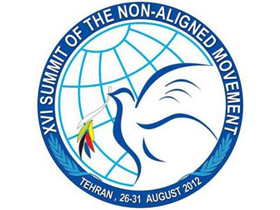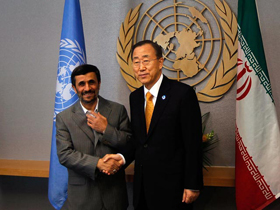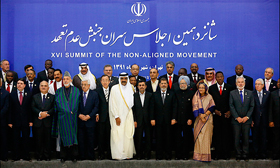The non-aligned movement today
In
Login if you are already registered
(no votes) |
(0 votes) |
Ph.D in History, Professor of MGIMO University, Ambassador Extraordinary and Plenipotentiary
The past 50 years have been tortuous for the Non-Aligned Movement (NAM). Born in the 1960s as a response by developing countries to the global divide into blocs, since the Cold War the Movement has been searching for new reasons to exist. With the multipolar world under construction, the NAM is getting a new lease of life and may become a new world center of power. And it seems truly problematic to chart a course through the tumult of international affairs and shape a viable foreign policy, unless you have a proper understanding of the NAM’s problems.
The past 50 years have been tortuous for the Non-Aligned Movement (NAM). Born in the 1960s as a response by developing countries to the global divide into blocs, since the Cold War the Movement has been searching for new reasons to exist. With the multipolar world under construction, the NAM is getting a new lease of life and may become a new world center of power. And it seems truly problematic to chart a course through the tumult of international affairs and shape a viable foreign policy, unless you have a proper understanding of the NAM’s problems.
From Non-Alignment Philosophy to the United South
The Non-Aligned Movement is a complex product of ever-evolving international relations. The non-alignment doctrine materialized in the mid-20th century as part of the process of decolonization and during emergence of the new, post-colonial, independent states. Each having different goals, Movement members were united by a common desire to stay away from the military-political and ideological confrontation of the two main alliances.
After the bipolar system collapsed, the NAM lost relevance both in its basic concept of detachment from military blocs and in its title. This then set the Movement off in search of a new philosophy. As the West-East confrontation subsided, the previous balancing act was replaced by the drive to achieve a united South. And this is not a reference to any South-North confrontation, as NAM has neither the political nor the economic resources for any such feat. The Movement’s strategic goals have also been remodeled into a common shaping of developing countries’ bargaining positions vis-à-vis international financial organizations and the WTO, with the same strategy used as the basis for relationships with the United States, European Union, China and Japan.
The northbound pivot has helped the Movement avoid the risk of self-destruction and acquire a new more pragmatic agenda focused on sustainable development, in order to overcome backwardness and poverty in developing countries.
The implementation of these goals hinges not only on the approaches taken by the North, but also on the South’s ability to overcome the growing internal differences that weaken its bargaining potential. Actually, within the Movement, there are several groups of states pursuing their individual interests:
- The new rising economies of South East Asia, leading Latin American countries, RSA, Egypt, other African and Asian states, primarily energy exporters, interested in developing the markets of the South.
- The poorest African countries.
- Most of the states positioned between the two previous groups with the NAM-average development level, i.e. Algeria, Colombia, Morocco, Tunis, the Philippines, Ecuador, et al (about 60 in total).
Economic inequality within the NAM drives the advanced countries out of the Movement's formal boundaries. Approaching global power status, states like India, Indonesia and South Africa feel claustrophobic within the Movement, and reach out to new centers of power, for example the BRICS and the Shanghai Cooperation Organization.
Pragmatism and Revived Passionarity

At the summit, Iran is taking over from Egypt as
Chair of the Non-Aligned Movement for the period
2012 to 2015
An analysis of current trends within the NAM seems unfeasible if the following factors are neglected.
As has been mentioned, following a decline in activity during the unipolar period of international relations, the Movement is experiencing a revival. The vocal rhetoric of its former charismatic leaders is no longer in fashion, but the foreign policy approaches do acquire offensive elements. This renaissance stems from the particular nature of the Movement, as it unites developing countries, many of which are unlikely to catch up with the industrialized world any time soon. The heightened tensions in the Middle East, a region home to many non-aligned states is also important.
Another driver of this NAM resurgence is the chairmanship of Iran, which is to be replaced by Venezuela (provided Hugo Chavez does not leave his presidential post for health reasons). The final resolution of the August 2012 NAM summit condemned sanctions against Iran and recognized its right to the peaceful development of atomic energy. To the disapproval of the West, another statement insisted on a political settlement in Syria and the inadmissibility of foreign interference there. The resolution also supported Baghdad’s proposal to set up a group for the discussion of approaches to reaching a Syrian settlement involving Egypt, Iran, Venezuela and Iraq.
These NAM decisions are likely to matter in preventing the further escalation of tensions in the area, where a major regional war could be provoked – with dire global consequences.
However, signs of radicalization would not alter the Movement’s key goal, i.e. solving its members’ economic problems, which is unlikely to be achieved without pragmatic cooperation with the West. Hence, offensive rhetoric can remain but the policies should be orientated to obtaining financial aid and investment, restructuring debt, reforming international financial institutions, and fair trade. In order to solve these problems, the NAM should enhance coordination with international bodies, primarily with the UN, where the non-aligned states boast a two third majority (129 votes).
UN-ization of the Non-Alignment Movement
The Movement is engaged in a broad discussion of its further institutionalization, and the establishment of a structured international organization similar to the United Nations. Currently, there is a Coordinating Bureau in New York that exists to streamline NAM states’ positions within the UN Security Council, a foreign ministers’ troika mechanism as well as regional groups. The NAM presiding country has missions in New York, Geneva, Paris, Rome and Nairobi to de facto perform the functions of the Movement’s secretariat. However, certain member states insist on there being a permanent secretariat. Opinions differ. Rank-and-file NAM countries worry that the secretariat will turn into a supranational body in which equality would be hard, if not impossible, to attain. Some influential states are also hesitant, unwilling to see their hands tied. The same is true of the debate on other bureaucratic bodies, the NAM program and charter.
And all the key global actors take account of these factors in forming their approaches to the Movement.
Enforcement of Peace
Since its very establishment, the United States has been watching the Movement closely and directly cultivating its major members. After the Cold War, Washington decided that the NAM had lost its previous caliber, but has continued to monitor its internal processes, including through participation in Movement summits as a guest.
The Iranian presidency has considerably radicalized the U.S. attitude to the NAM, with the State Department trying hard to subdue the effects of the August 2012 summit in Tehran, curtail its participation and attach an anti-Iranian flavor to the final documents. However, this initiative failed, as over 100 states sent their representatives to Tehran, more than 30 of them led by heads of states and governments, and 80 by foreign ministers. The harshest blow came from UN Secretary General Ban Ki-moon, who also attended the event. Washington failed to guarantee the adoption of final documents castigating Iran and Syria. Notably, Western media censored incoming information from Tehran.
Mid-term forecasting of U.S. policy towards the Movement is risky. Since Venezuela will take on the presidency after Iran, Washington will likely step up its denunciation of the NAM along nationalistic lines. At the same time, the United States cannot ignore the opinion of the 120 Movement members, and may concentrate on engaging moderate regimes that are aspiring to have economic ties with the United States.
The EU’s approach to the NAM seems inconclusive. The key European countries are in no position to ignore the Movement’s dimensions or its members’ markets. To this end, Germany, interested both in boosting its exports and obtaining NAM states’ support to be elected permanent member of the UN Security Council, is particularly active.
At the same time, the EU is trying to temper the Movement’s anti-western radicalism and prevent a North-South confrontation. In this context, Brussels should bear in mind the position of Washington, unhappy both with a stronger NAM role in international affairs and with European inroads to non-aligned countries’ markets.
Watching from the Mountain
China is doing a lot to bring the non-aligned states into its orbit. Concentrating on developing their markets for Chinese exports and obtaining their energy and commodities, Beijing assertively outpaces Great Britain and France, the former colonial powers. At the same time, China will not adopt binding political obligations, confining itself to monitoring trends within the Movement and sending representatives to NAM summits at which it has observer status. The Chinese representative in Tehran’s address underlined that Beijing attached great importance to the positive role played by the Movement in the world. However, Beijing will not display high levels of political activity, nor will it advance any initiatives. This line corresponds with its overall foreign strategy to date, which is built on staying low-profile.
Moving fast toward global power status, India is losing interest in NAM leadership, and is increasingly unwilling to be associated with the South. Proceeding from its political and economic potential, Delhi rather claims the role of a Northern country in order to maintain a strong position as regards the developing markets. However, the less developed non-aligned states prefer to open markets to traditional Western partners who used to render them occasional free economic aid, at least before the global crisis.
Speaking the Multipolar Language: Russia and the Non-Aligned Movement
During the Cold War, the USSR tried to employ the Movement, or at least some of its participants, in the anti-imperialist struggle. Although consistent and pinpointed, the policy was not effective. The NAM countries felt uneasy about getting involved in a confrontation between the two great alliances and avoided any clear-cut wording or obligations. After the Soviet Union’s collapse, Russia lost interest in the Movement and the developing countries as a whole, instead backing the West, which was then viewed as an ideological ally. The change in Russia’s ruling elite gave rise to a multi-pronged policy, which also included the development of relations with the Movement. There are no grounds to regard this as a priority, since Russia’s focus remains on the West (albeit now without any ideological bias) and on the pivot to the East, primarily to China. In this context, though the NAM cannot be seen as a key factor in global politics, it is definitely integral to the multi-pronged policy and deserves broader cooperation. Besides, Russia does not want to be viewed by the South as a country of the rich North. Russia’s Eurasian nature and its participation in the BRICS and the SCO make it fluent in the multipolar languages of the North, East and South. Also important is the fact that Russia is no longer a superpower in a position to threaten NAM interests. That said, the Movement respects the status Russia has due to its membership of the UN Security Council, the G20 and the G8.
These factors make Russia more attractive to the Movement: attractive enough for the establishment of an official bilateral relationship.
Moscow was given guest status at NAM forums. There is formalized contact between Russia and the NAM troika within the foreign minister format, and consultations at the deputy foreign minister and expert levels. Russia also uses a NAM diplomatic mechanism based on interaction with the presiding state, that effectively shapes the Movement’s policies, as well has as a permanent contact with NAM missions, for example in New York.
Russia cannot neglect the future presidency of Iran, a country that has a certain prominence on the global arena. President Putin’s address to the Tehran summit confirmed Russia’s readiness to boost cooperation with the Movement. To this end, Russian representation in Tehran by an ambassador-at-large seemed somewhat unbalanced since many delegations were led by heads of state and government or foreign ministers. Russia’s relatively unassuming presence did not go unnoticed, with the situation aggravated by the difficulties that the ambassador-at-large faced in contacting higher placed leaders of other delegations.
Instead of a Forecast
As far as the Movement’s future is concerned, one can be confident that it has grown into a key tool of the developing countries within the South-North dialogue, the significance of which will only grow.
Importantly, certain rising economies opt to reject the stereotypical categories of South and North, insisting that, in economic terms, some states of the South are on a level with those in the North.
In the mid-term, the Non-Aligned Movement is likely to preserve its status in global politics, since its countries make up 55 percent of the planet’s population, possess 76 percent of the world oil reserves (66 percent produced) and 53 percent of global gas reserves (39 percent produced), with all OPEC states inside the NAM.
At the same time, the Movement remains disunited on many international problems, which is both a strength and a weakness. Economic differentiation, that defines the diverging interests of member countries, and structural looseness effectively prevent the formation of a single unified front on certain key issues including the nonproliferation of nuclear weapons, and regional conflict resolution. But the varying attitudes and the absence of a rigid vertical structure only strengthen democratic trends within the NAM, while also upholding its two-thirds presence in the UN.
(no votes) |
(0 votes) |







